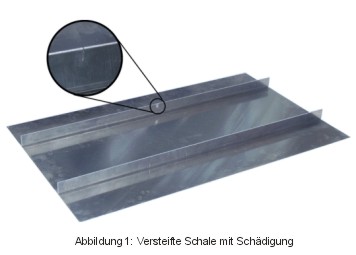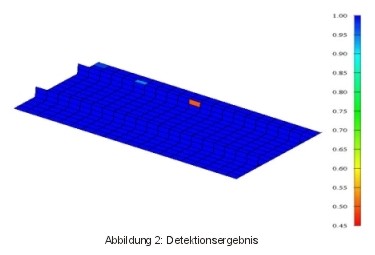Within the context of monitoring the airworthiness of a plane, it is necessary to check the whole plane’s structural integrity. Different methods are used for detection and localisation of macroscopic and microscopic damage. The disadvantage of visual inspections is that they can just be done in certain intervals and the great extent of lavishness which concludes from the need to dismantle large parts of the interior very often. An efficient and cheap way of monitoring is the measuring of elongations, accelerations and other structural replies by means of suitable sensors. These measuring data are compared with reference data of an intact structure from an analysis or from a reference measuring.
 Because of the differences between the structural replies of damaged and undamaged structure it is possible to determine the existence and position of damage. This requires an appropriate selection of structural replies and position of sensors. The aim of the project ODESA is the development of methods and software to determine the position of damage by means of mathematic methods of optimisation. Furthermore the development of a system to determine an optimal disposition of a limited number of pickup sensors is in progress. The developed techniques should be validated in different structures which are typically used in aircraft construction. Because of the differences between the structural replies of damaged and undamaged structure it is possible to determine the existence and position of damage. This requires an appropriate selection of structural replies and position of sensors. The aim of the project ODESA is the development of methods and software to determine the position of damage by means of mathematic methods of optimisation. Furthermore the development of a system to determine an optimal disposition of a limited number of pickup sensors is in progress. The developed techniques should be validated in different structures which are typically used in aircraft construction.
Presently a strutted flat structure is analysed. As it is shown on illustration 1 the stringer should be detected and localised. Within the scope of the project, modeshapes of the structure were measured by a laservibrometer. The location and extension of damage can be determined because of variances resulting from the occurrence of damage. For this purpose a Finite Element model was used. Firstly, the optimal positions for the measurement with the laservibrometer were found out. After the Finite Element model was adapted as good as possible to the measured structural replies by means of optimisation methods the real identification of damage was accomplished. As it is shown on illustration 2 the result of the localisation of the strutted flat is very good.  Current working topics are on the one hand a further improvement of the algorithms for sensor positioning whereupon sensor setups with a different number of sensors should be compared as well. On the other hand the process should be extended by further measuring categories, e.g. strain which can be acquired by DMS or piezo-electric sensors. In addition the FE-model’s adaptation to measured structural replies of the undamaged component, the so called model-updating, is improved. It is called because of its great influence on the quality of the localisation of damage. Current working topics are on the one hand a further improvement of the algorithms for sensor positioning whereupon sensor setups with a different number of sensors should be compared as well. On the other hand the process should be extended by further measuring categories, e.g. strain which can be acquired by DMS or piezo-electric sensors. In addition the FE-model’s adaptation to measured structural replies of the undamaged component, the so called model-updating, is improved. It is called because of its great influence on the quality of the localisation of damage.
The project is accomplished in co-operation with the EADS. |